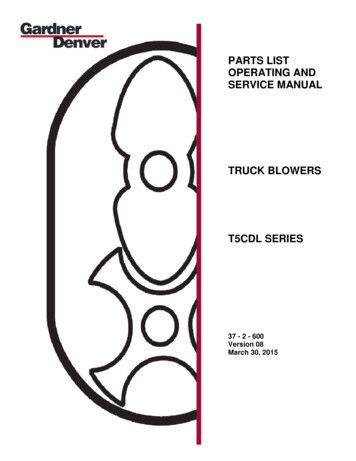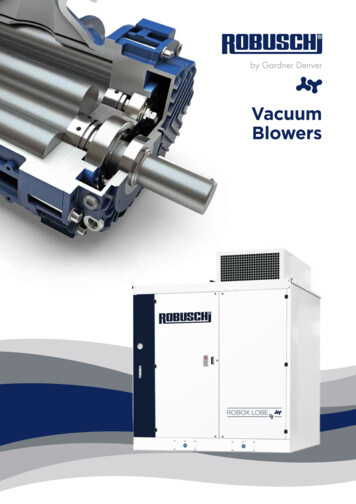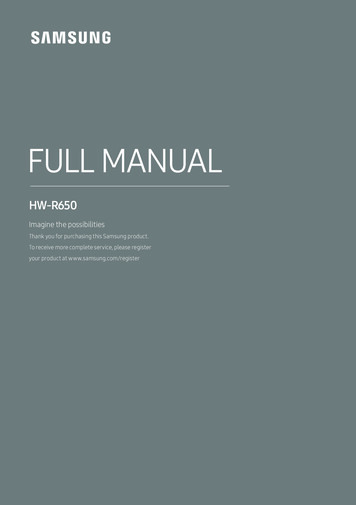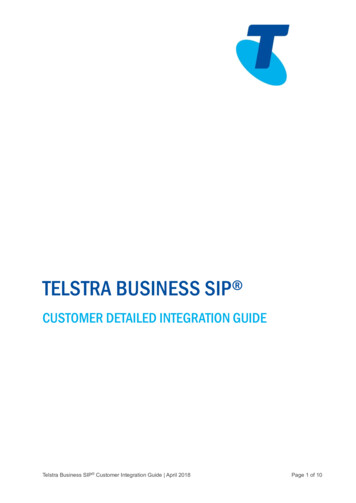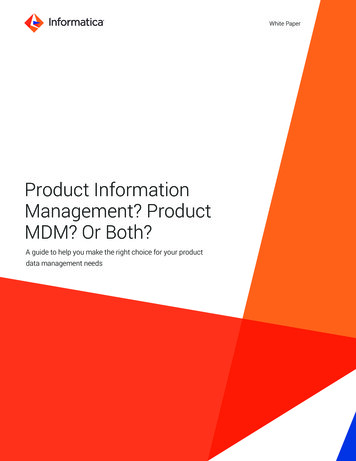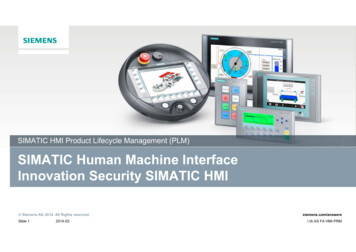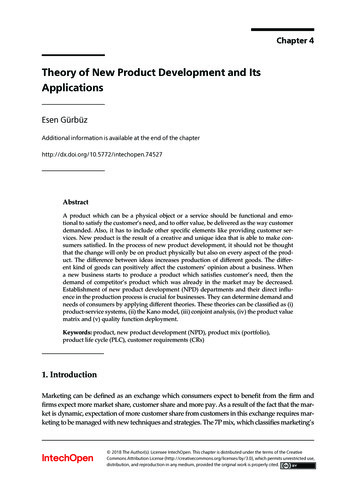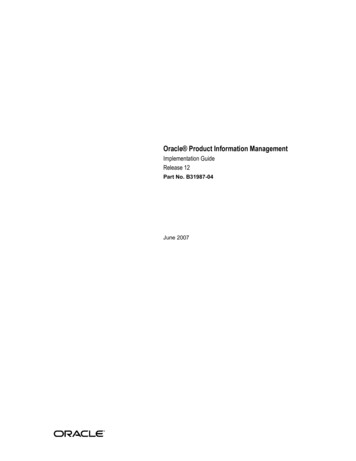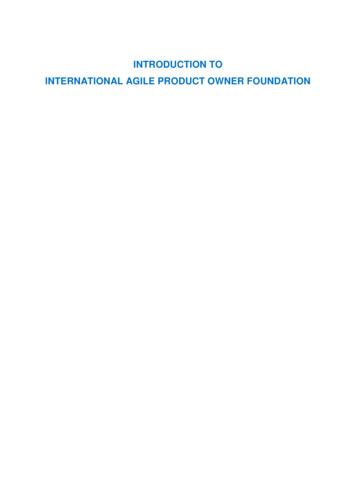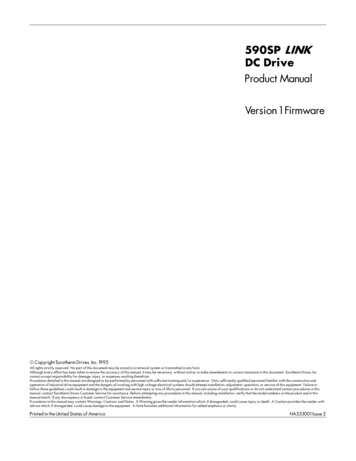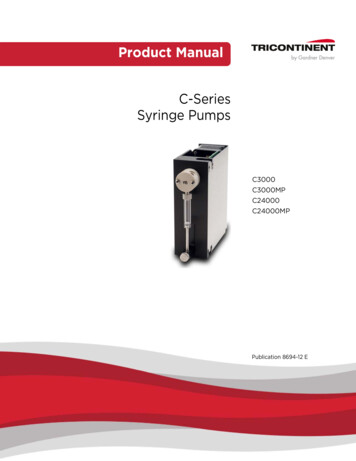
Transcription
Cover pageProduct ManualC-SeriesSyringe PumpsC3000C3000MPC24000C24000MPPublication 8694-12 E
Copyright 2017, Gardner Denver TriContinent. All rights reserved.NOTICEThe information presented in this material is based on technical data andtest results of nominal units. It is believed to be accurate and reliable andis offered as an aid to help in the use of TriContinent products. It is theresponsibility of the user to determine the suitability of the product forthe intended use and the user assumes all risk and liability in connectiontherewith. TriContinent does not warrant, guarantee or assume any obligation or liability in connection with this information.Publication 8694-12 E
Contents1 About this manualIntroduction . . . . . . . . . . . . . . . . . . . . . . . . . . . . . . . . . . . . . . . .Audience . . . . . . . . . . . . . . . . . . . . . . . . . . . . . . . . . . . . . . . . . . .Products covered by this manual. . . . . . . . . . . . . . . . . . . . . .Parts of this manual. . . . . . . . . . . . . . . . . . . . . . . . . . . . . . . . . .77772 Safety and standardsAbout this chapter. . . . . . . . . . . . . . . . . . . . . . . . . . . . . . . . . . . 9Safety notifications used in this manual . . . . . . . . . . . . . . . . 9ESD precaution . . . . . . . . . . . . . . . . . . . . . . . . . . . . . . . . . . . . . 9Proper use of equipment . . . . . . . . . . . . . . . . . . . . . . . . . . . . 10Syringe shipping precaution . . . . . . . . . . . . . . . . . . . . . . . . . 10Regulatory notices . . . . . . . . . . . . . . . . . . . . . . . . . . . . . . . . . 103 Product overviewAbout this chapter. . . . . . . . . . . . . . . . . . . . . . . . . . . . . . . . . . . 11General description . . . . . . . . . . . . . . . . . . . . . . . . . . . . . . . . . . 11Features and facilities . . . . . . . . . . . . . . . . . . . . . . . . . . . . . . . .13Key specifications . . . . . . . . . . . . . . . . . . . . . . . . . . . . . . . . . . .144 Installation instructionsAbout this chapter. . . . . . . . . . . . . . . . . . . . . . . . . . . . . . . . . . .15Unpacking . . . . . . . . . . . . . . . . . . . . . . . . . . . . . . . . . . . . . . . . . .15Before starting . . . . . . . . . . . . . . . . . . . . . . . . . . . . . . . . . . . . . .16Basic requirements . . . . . . . . . . . . . . . . . . . . . . . . . . . . . . . .16Protocol and interface options . . . . . . . . . . . . . . . . . . . . . .17Obtain and install TCS Pump Commander if needed. . .18Download and install USB driver if needed . . . . . . . . . . .18Power and electrical considerations . . . . . . . . . . . . . . . . .19Place or mount pump(s) . . . . . . . . . . . . . . . . . . . . . . . . . . . . 20Before mounting . . . . . . . . . . . . . . . . . . . . . . . . . . . . . . . . . 20Mounting . . . . . . . . . . . . . . . . . . . . . . . . . . . . . . . . . . . . . . . . 20Set configuration jumpers and address switch . . . . . . . . . 22C-Series Product Manual8694-12 E3
Make electrical connections . . . . . . . . . . . . . . . . . . . . . . . . . 24Connector J3 pin assignments . . . . . . . . . . . . . . . . . . . . . 24Install communication/power cabling. . . . . . . . . . . . . . . 25Control wiring (auxiliary inputs and outputs) . . . . . . . . 29Confirm communication with pump . . . . . . . . . . . . . . . . . . 29Confirm with TCS Pump Commander (RS232/485) . . 29Confirm with terminal emulation programs . . . . . . . . . . 30Initialize pump . . . . . . . . . . . . . . . . . . . . . . . . . . . . . . . . . . . . . .31Initialize with TCS Pump Commander. . . . . . . . . . . . . . . .31Initialize with terminal emulation programs. . . . . . . . . . 32Check LED indicators . . . . . . . . . . . . . . . . . . . . . . . . . . . . . 33Install syringe . . . . . . . . . . . . . . . . . . . . . . . . . . . . . . . . . . . . . . 34Connect tubing. . . . . . . . . . . . . . . . . . . . . . . . . . . . . . . . . . . . . 365 Operating instructionsAbout this chapter. . . . . . . . . . . . . . . . . . . . . . . . . . . . . . . . . . 37Operation overview. . . . . . . . . . . . . . . . . . . . . . . . . . . . . . . . . 38Interface requirements review . . . . . . . . . . . . . . . . . . . . . . . 38Command guidelines . . . . . . . . . . . . . . . . . . . . . . . . . . . . . . . 39Command structure . . . . . . . . . . . . . . . . . . . . . . . . . . . . . . 39Addressing . . . . . . . . . . . . . . . . . . . . . . . . . . . . . . . . . . . . . . 39Command syntax. . . . . . . . . . . . . . . . . . . . . . . . . . . . . . . . . 40Command execution guidelines . . . . . . . . . . . . . . . . . . . . .41Execution controls. . . . . . . . . . . . . . . . . . . . . . . . . . . . . . . . .41Initializing pumps. . . . . . . . . . . . . . . . . . . . . . . . . . . . . . . . . . . 42Initialization sequence . . . . . . . . . . . . . . . . . . . . . . . . . . . . 42Initialization commands . . . . . . . . . . . . . . . . . . . . . . . . . . . 43Priming syringe and tubing . . . . . . . . . . . . . . . . . . . . . . . . . . 47Valve movements . . . . . . . . . . . . . . . . . . . . . . . . . . . . . . . . . . 48Valve selection information . . . . . . . . . . . . . . . . . . . . . . . . 48Making valve movements. . . . . . . . . . . . . . . . . . . . . . . . . . 48Movements for non-distribution valves(3-port and 4-port) . . . . . . . . . . . . . . . . . . . . . . . . . . . . . 49Movements for T valves (3-port and 4-port). . . . . . . . . 52Movements for distribution valve(3-way with U4 config). . . . . . . . . . . . . . . . . . . . . . . . . . 54Movements for distribution valves(3-way with U11 config; and 6-way) . . . . . . . . . . . . . . . 56Movements for 4-port loop valve. . . . . . . . . . . . . . . . . . . 59Plunger movements . . . . . . . . . . . . . . . . . . . . . . . . . . . . . . . . .61Increments and resolution . . . . . . . . . . . . . . . . . . . . . . . . . .61Set plunger resolution (increment) mode (N) . . . . . . . . 62Converting increments to volume resolution . . . . . . . . 62Plunger move commands . . . . . . . . . . . . . . . . . . . . . . . . . 63Configuring plunger movement . . . . . . . . . . . . . . . . . . . . 65Configuring auxiliary connections . . . . . . . . . . . . . . . . . . . . .714Contents
Execution control commands . . . . . . . . . . . . . . . . . . . . . . . . 73Using EEPROM . . . . . . . . . . . . . . . . . . . . . . . . . . . . . . . . . . . . . 78Report commands (query commands) . . . . . . . . . . . . . . . . 86Status and error codes . . . . . . . . . . . . . . . . . . . . . . . . . . . . . . 88Non-functional commands . . . . . . . . . . . . . . . . . . . . . . . . . . .91Command summaries . . . . . . . . . . . . . . . . . . . . . . . . . . . . . . . 92RS232/RS485 command summary . . . . . . . . . . . . . . . . . 92CAN Bus command summary . . . . . . . . . . . . . . . . . . . . . . 976 MaintenanceAbout this chapter. . . . . . . . . . . . . . . . . . . . . . . . . . . . . . . . . . 99Routine maintenance . . . . . . . . . . . . . . . . . . . . . . . . . . . . . . . 99Replacing components. . . . . . . . . . . . . . . . . . . . . . . . . . . . . 100Replacing syringe . . . . . . . . . . . . . . . . . . . . . . . . . . . . . . . 100Replacing valve . . . . . . . . . . . . . . . . . . . . . . . . . . . . . . . . . 1027 TroubleshootingAbout this chapter. . . . . . . . . . . . . . . . . . . . . . . . . . . . . . . . .Performing diagnostic self test. . . . . . . . . . . . . . . . . . . . . .Symptoms and solutions . . . . . . . . . . . . . . . . . . . . . . . . . . .Error code listing . . . . . . . . . . . . . . . . . . . . . . . . . . . . . . . . . .1051061071098 Customer supportAbout this chapter. . . . . . . . . . . . . . . . . . . . . . . . . . . . . . . . . . 111Contacting Customer Service . . . . . . . . . . . . . . . . . . . . . . . . 111Ordering parts and accessories . . . . . . . . . . . . . . . . . . . . . . 112Warranty and return information . . . . . . . . . . . . . . . . . . . . . 1129 Reference informationAbout this chapter. . . . . . . . . . . . . . . . . . . . . . . . . . . . . . . . . . 113Pump addressing scheme . . . . . . . . . . . . . . . . . . . . . . . . . . . 114OEM communication protocol . . . . . . . . . . . . . . . . . . . . . . . 115OEM protocol command block characters. . . . . . . . . . . 115OEM protocol answer block characters . . . . . . . . . . . . . 118Data Terminal (DT) protocol . . . . . . . . . . . . . . . . . . . . . . . . . 119DT protocol command block characters . . . . . . . . . . . . 119DT protocol answer block characters . . . . . . . . . . . . . . 120CAN interface communications . . . . . . . . . . . . . . . . . . . . . . 121CAN messages . . . . . . . . . . . . . . . . . . . . . . . . . . . . . . . . . . . 121C-Series Product Manual8694-12 E5
TCS Pump Commander quick reference guide . . . . . . . . . 131User Interface overview . . . . . . . . . . . . . . . . . . . . . . . . . . . 131Communication Setup area . . . . . . . . . . . . . . . . . . . . . . . . 131Single String area. . . . . . . . . . . . . . . . . . . . . . . . . . . . . . . . .132String Sequencer area . . . . . . . . . . . . . . . . . . . . . . . . . . . .133Evaluation cables and accessories . . . . . . . . . . . . . . . . . . . 134RS232 to single or multiple devices evaluation. . . . . . .135USB to multiple device evaluation . . . . . . . . . . . . . . . . . 136Single device evaluation with direct USB input . . . . . .137PTFE vs. UHMWPE for syringe seals and valve plugs . . 138Calculating flow rates . . . . . . . . . . . . . . . . . . . . . . . . . . . . . . 139Chemical compatibility chart information . . . . . . . . . . . . . 141Precision and accuracy. . . . . . . . . . . . . . . . . . . . . . . . . . . . . 143Overview . . . . . . . . . . . . . . . . . . . . . . . . . . . . . . . . . . . . . . . 143Important variables . . . . . . . . . . . . . . . . . . . . . . . . . . . . . . 143Optimizing pump performance . . . . . . . . . . . . . . . . . . . . . 145Optimizing tubing performance . . . . . . . . . . . . . . . . . . . . . 147Dual pump continuous flow application . . . . . . . . . . . . . . 149Introduction . . . . . . . . . . . . . . . . . . . . . . . . . . . . . . . . . . . . 149Sequence of operation . . . . . . . . . . . . . . . . . . . . . . . . . . . 149Tubing hookup . . . . . . . . . . . . . . . . . . . . . . . . . . . . . . . . . . 150Wiring. . . . . . . . . . . . . . . . . . . . . . . . . . . . . . . . . . . . . . . . . . 150Jumper and address switch settings . . . . . . . . . . . . . . . 150Programming . . . . . . . . . . . . . . . . . . . . . . . . . . . . . . . . . . . . 15110 Revision historyRevision history table . . . . . . . . . . . . . . . . . . . . . . . . . . . . . . .1556Contents
1About this manualIntroductionThis comprehensive manual provides the instructions you need to get theC-Series Syringe Pumps installed and operating as desired, as well as to keepproperly maintained. Contact information is also included in case you need toreach TriContinent for assistance. See "Customer support" (page 111).AudienceThis manual is provided primarily for customers who purchase products fromTriContinent. It is expected that the majority of customers are instrumentdesigners and software engineers who are familiar with this type of productand existing software/firmware of similar design. However, this manual is alsodesigned to accommodate those who don’t have such familiarity or who simply wish to learn more about the product.Products covered by this manualThe following products are covered by this manual: C3000 C3000MP C24000 C24000MPThese are described in "Product overview" (page 11).Parts of this manualThe following parts are included in this manual: About this manual, this chapter Safety and standards, page 9 Product overview, page 11 Installation instructions, page 15 Operating instructions, page 37 Maintenance, page 99 Troubleshooting, page 105 Customer support, page 111 Reference information, page 113 Revision history, page 155C-Series Product Manual8694-12 E7
This page intentionally blank
2Safety and standardsAbout this chapterThis chapter contains safety notifications used in this manual, cautions aboutproper use of the equipment, and standards which may be applicable to theC-Series Syringe Pumps.The C-Series Syringe Pumps are designed to meet recognized technical regulations and are built with state-of-the-art components. Nevertheless, risks tousers, property and/or the environment can result when they are used carelessly or improperly. Appropriate warnings in this manual are included tonotify of possible hazards.Safety notifications used in this manualCAUTION: Alerts you to the possibility of equipment damage and/orimproper function if these instructions are not followed.WARNING! Indicates a hazardous situation which, if not avoided, couldresult in injury and/or property damage.DANGER! Indicates a hazardous situation which, if not avoided, can result indeath or serious injury and property damage. This alert is limited to the mostextreme situations.ESD precautionCAUTION: ESD-sensitive equipment!Always use proper ESD practices when handling the C-Series Syringe Pumps.Because it is an electronic device, the pump is vulnerable to ESD (electrostatic discharge). Electrostatic discharge can come from common objects,fixtures, and flooring materials such as carpets, causing the pump to fail prematurely. Proper ESD practices include the use of static-free work areas, wristor ankle grounding straps, ESD mats, non-static flooring material or treatment, and similar provisions.C-Series Product Manual8694-12 E9
Proper use of equipmentProper use of equipmentThe C-Series Syringe Pumps are designed for pipetting and dispensing operation. Any other use may damage the pump and/or produce unreliableresults.Make sure any liquids used with the equipment are compatible. Refer to thechemical compatibility chart (page 142).Note: It is the responsibility of the purchaser to determine the suitability ofan application and material compatibility of the products.Syringe shipping precautionCAUTION: Avoid shipping pumps with syringes installed. During transport,shock and vibration can be transmitted directly to the syringe. This can leadto glass breakage, loosening of syringes from their threaded ports, andpotentially other problems. Syringes should always be shipped separatelyinside their original packaging for the highest level of protection fromdamage. Using the pumps’ original packaging is insufficient.For example, when shipping pumps that have been installed in an instrument,syringes should be removed and shipped in their individual packaging asdescribed above.Regulatory noticesFDAThe TriContinent C-Series Syringe Pumps are general laboratory components. Because they are not medical devices, they are not subject to FDAapproval.CEThe C-Series Syringe Pumps are modular devices intended for incorporationinto larger systems, which themselves require independent certification.Therefore, the C-Series Syringe Pumps do not have their ownmark.RoHSThe TriContinent C-Series Syringe Pumps are RoHS compliant. They are constructed of components that meet the requirements set by the EuropeanUnion’s Restriction of Hazardous Substances Directive 2002/95/EC.10Safety and standardsChapter 2
3Product overviewAbout this chapterThis chapter provides a general introduction to the C-Series Syringe Pumps,including features, facilities, and key specifications.The following parts are included: About this chapter, page 11 General description, page 11 Features and facilities, page 13 Key specifications, page 14General descriptionFigure 3-1. Typical C-Series PumpThe C-Series Syringe Pumps are OEM pump modules designed for automated instrumentation.The module is a self-contained unit that includes the pump, stepper motors,control electronics, drive, and valve. The C-Series pumps utilize a proprietaryhigh-efficiency, direct-drive design instead of belts that can stretch or wearout. The robust drive mechanism has been life tested to several million cycleswith no maintenance required during its lifetime.These pumps are excellent choices for new installations, and for replacements where experienced IVD instrument manufacturers would like to maximize investments they have already made in instrumentation. The C-Seriespumps utilize standard communication interfaces and methods for mountingused by other compact syringe pump designs. The pumps are outfitted withTriContinent long-life valves available in various configurations and materialcombinations. All C-Series pumps can be customized for specific liquid handling needs.C-Series Product Manual8694-12 E11
General descriptionThe C-Series hardware and firmware automatically detect the communicationinterface and communication protocol. The pump can be configured to operate at different communication speeds.There are currently four models of the C-Series Syringe Pumps: C3000.C3000MP, C24000, and C24000MP.C3000. The C3000 provides all normal aspiration and dispensing operations expected from an OEM syringe pump module. The stepper motordriven syringe will accurately and precisely handle fluid capacities from a fewmicroliters to 12.5 milliliters. The syringe drive arm can be easily back driven,making syringe installation or replacement extremely quick and easy. TheC3000 supports valves with 3 or 4 ports.C3000MP (C3000 Multiport). The C3000MP provides all of the features of the C3000 but is designed to support a 6-way distribution valve.C24000. The C24000 is a high-resolution version of the C3000 thatachieves full syringe resolution to 192,000 increments/full stroke. TheC24000 is ideal for achieving low flow rate and meeting low pulsationrequirements. The C24000 supports valves with 3 or 4 ports.C24000MP (C24000 Multiport). This model has all the features ofthe C24000 but is designed to support a 6-way distribution valve.12Product overviewChapter 3
Features and facilitiesFeatures and facilitiesEach pump provides two digital inputs and three outputs (digital I/O) thatcan be used for synchronization with external devices (see Figure 3-2.) Multipump communication is possible over an RS485 or CAN bus. The built-inRS232 interface automatically converts to RS485. With an optional converter,USB communication can also be accommodated.Other features Proprietary high-efficiency and maintenance-free direct drive system Long-life rotary shear valves (up to 24 times the life of competing valves) Valve drive 250 ms between neighboring ports High resolution options available up to 192,000 increments/full stroke Up to 15 pumps on a bus; can be addressed individually Syringe sizes from 50 µL to 12.5 mL LED indicators to assist in monitoring function and provide notificationof specific error conditions.Figure 3-2. Facilities on C-Series pumpsFront ViewRear ViewLED IndicatorsValveCommunication,power, Digital IOD-sub15 pinConnectorSyringeAddress SwitchConfigurationJumperAdditional jumperunderneath providescommunication bustermination.C-Series Product Manual8694-12 E13
Key specificationsKey specifications Interface: RS232, RS485, CAN Communication rates: RS232/RS485: 9600 or 38400 baud; CAN: 100K,125K, 250K, 500K, 1M bps Format (RS232/RS485): Data bits 8, Parity None, Stop Bit 1, half duplex Operating Temperature 15 C to 40 C (59 F to 104 F) Humidity 20 to 95% RH at 40 C (104 F)More detailed specifications can be seen at http://www.tricontinent.com.Product data sheets can be downloaded from this location.14Product overviewChapter 3
4Installation instructionsAbout this chapterThis chapter describes how to install your C-Series Syringe Pumps.The following parts are included: About this chapter, page 15 Unpacking, page 15 Before starting, page 16 Place or mount pump(s), page 20 Set configuration jumpers and address switch, page 22 Make electrical connections, page 24 Confirm communication with pump, page 29 Initialize pump, page 31 Install syringe, page 34 Connect tubing, page 36UnpackingCAUTION: Always use proper ESD practices when handling the C-SeriesSyringe Pumps.1. Remove items from shipping carton.2. Check the contents against the packing slip to make sure that all thecomponents are present. If any components are missing or damaged, seeinstructions in Customer support (page 111).3. Dispose of packing material in accordance with local environmental regulations.C-Series Product Manual8694-12 E15
Before startingBefore startingBasic requirementsBasic requirements for installing your C-Series Syringe Pumps are listedbelow. If you have any difficulty obtaining any of them, you can get assistancefrom Customer Service. See Customer support (page 111). Desired syringe that is compatible with the C-Series Syringe Pumps. Tubing appropriate to the pump and valves and the nature of fluid to bemoved. For guidance on selecting tubing, refer to "Optimizing tubingperformance" (page 147). Cabling as needed. Computer, Windows based, to serve as the Host Controller. If you are going to use the USB port of your host computer to connect tothe C-Series pump, you will need a USB-to-RS485 converter, which canbe ordered through TriContinent Customer Service. A software interface for communicating with the pump or pumps.–For evaluation purposes, the TCS Pump Commander user interface isrecommended. See "Obtain and install TCS Pump Commander ifneeded" (page 18).Alternatively, terminal emulator programs such as PuTTY andRealTerm are available. These may be obtained from Customer Service.–For instrument development, only an appropriate communicationsport on the Host Controller PC is needed.Details concerning interface selection are included on page 17.16Installation instructionsChapter 4
Before startingProtocol and interface optionsProtocolThree communication protocols are available: OEM communications protocol Data Terminal (DT) protocol CAN protocolThe C-Series firmware automatically detects which protocol is in use.Communication standardsThe C-Series Syringe Pumps use the following communication standards. RS232 RS485 CANThese communication standards are described in detail in Chapter 9, Reference information (page 113).Interface SelectionA terminal program or the TCS Pump Commander may be used for directoperator input to the pumps. Note that TCS Pump Commander is especiallyrecommended for use in evaluating pump behavior in response to commands. Other terminal programs such as PuTTY and RealTerm may be used.Customer Service can provide assistance in obtaining these if necessary.Table 4-1: Protocol and interface summaryHardware/electricalinterfaceCommunication protocols/standardsRS232 and RS485CANCommentsConnectionDT or OEM protocolDT is recommended for usewith terminal emulatorprograms. DT is automaticallyselected when TCS PumpCommander is used.OEM is recommended forinstrument developmentbecause of its robust errorchecking and correction.Serial or USB computer portSerial connects directly to serialinputs on one pump; RS485 toremaining pumps on bus(daisy-chain).USB goes through an externalUSB/RS485 converter, whichconnects directly to the RS485bus on a pump.Cables are available for theseconnections. ContactCustomer Service (page 111).CAN (hardware/electricalinterface and communication protocol are included inCAN specification.)If assistance is needed, contact Customer Service (page 111).C-Series Product Manual8694-12 E17
Before startingObtain and install TCS Pump Commander if neededThe TCS Pump Commander interface is recommended for evaluation purposes. The TCS Pump Commander displays how commands are structured,and shows the interaction between pumps and commands.To obtain TCS Pump Commander, email a request to Liquidhandling,TCS@tricontinent.com. You will be provided with further instructions.Download and install USB driver if neededThe USB driver is required only when the TriContinent USB converter is beingused to communicate with C-Series Syringe Pumps.If using other third-party USB converters, follow their instructions for downloading and installing drivers.Note: When using the TCS Pump Commander, you will need to know whichCOM port will be used for communicating with the C-Series pump.1. Go to this link to download the USB driver for your system: software/usb-to-uartbridge-vcp-drivers.This takes you to a web page of Silicon Labs, where the USB drivers forvarious systems are listed.Note: It is possible for the link above to change. If this occurs, contactCustomer Service for assistance or search elsewhere on the Silicon Labswebsite for the USB drivers.2. Click on whichever link is appropriate for your system, and follow directions to download the file.Note: Do not download files named “VCP with Serial Enumeration.”3. Extract the zip file.4. Open the resulting folder, which has the same name as the zip file.5. Run (double click) the appropriate .exe file for your system:––If your system is 64 bit, run CP210xVCPInstaller x64.exe.If your system is 32 bit, run CP210xVCPInstaller x86.exe.6. Follow the prompts to complete the installation.7. Insert the USB/RS485 converter into the USB port. Windows should recognize it and load the correct driver for the converter. Once this is done,the USB converter is ready to use.18Installation instructionsChapter 4
Before startingPower and electrical considerationsThe C-Series pump has the following power requirements: Input voltage: 24 VDC 10% Input current; 1.5 A peak current max., 650 mA average (RMS) currentmax., and 100 mA typical idle currentPower supply requirement for single pumpThe 24V DC supply for a single C-Series pump should meet the followingrequirements: Output voltage: 24V nominal 10% with good regulation Conformance to required safety and EMI/RFI specifications If switching supply, minimum load specification less than pump idlecurrent (above)Power supply sizing for multiple pumpsWhen operating more than one C-Series pump, the power supply should besized to provide the total peak current for all devices. If pumps are not operating simultaneously, a power supply with a reduced rating may be used. Theminimum power supply rating should be confirmed by measurement.It is suggested that an appropriately designed commercial power supply beused. When using a switching power supply, make sure it has a minimum loadspecification that is less than the total minimum current draw (idle current,above) from the pumps.CablingTo reduce voltage drops and increase noise immunity, it is good practice touse one power cable for every two pumps. Power lines to the pump should be24 AWG or heavier, and as short as possible, based on the total currentthrough the wires. Multiple C-Series pumps can be daisy-chained, providedthat the wire size and the power supply are adequate for the total current andvoltage drop. It is good practice to twist together each pair that connectsdirectly from a power supply to a pump.Switches should not be located in line with the DC input of the pumps toapply and remove power. This can result in damage to the equipment.For available evaluation cabling, please refer to "Evaluation cables and accessories" (page 134).C-Series Product Manual8694-12 E19
Place or mount pump(s)Place or mount pump(s)Before mountingTermination jumper J9 is located on the bottom of the pump. To avoid laterinconvenience during installation, make sure it is set correctly for your situation before securing the pump on a surface. Proper terminations are indicated in "Install communication/power cabling" (page 25).MountingThe pumps may be secured at the top, bottom, or either side by four prethreaded M3 X 0.5mm mounting holes. Refer to Figure 4-1 for mounting holelocations and dimensions.The upright position is used for best priming. For air displacement applications this is not necessary.20Installation instructionsChapter 4
Place or mount pump(s)Figure 4-1. Mounting holes and dimensions4 holes ** All mounting holes areM3 X 0.5 mm X 6.3 mm deep min.2 holes4 holes each sidefor total of 8 **4 holes *All dimensions, unless otherwisespecified: .XXX .008 [0.2 mm]C-Series Product Manual8694-12 E21
Set configuration jumpers and address switchSet configuration jumpers and address switchConfiguration jumpersBefore operating the pump, jumpers J2 and J9 must be set for your system. Refer to the following tables and to Figure 4-2.Table 4-2: J2, various optionsJumperSegmentFunctionAction1ReservedNone. Spare jumper placed on this segment at factory.2AutoRunInstalled AutoRun1Remove if unused. Recommend removing until operation has been confirmed. AutoRun executes string in EEPROM at power-up.3Overload detectionInstalled disabled4RS232/485 communication rateInstalled 38,400 baudRemoved 9600 baud5Valve type in useInstalled 120 3-port valvesRemoved 90 4-port valves and all other valve types21.At power-up, if the AutoRun jumper is installed, the pump will execute the string at the memory location pointedto by the address switch setting.2.All other valve types are EEPROM configurable. This is described in Table 5-1 (page 48).Table 4-3: J9, RS485 and CAN on1RS485 A terminationInstalled terminatedRemove if unused.2RS485 B terminationInstalled terminatedRemove if unused.Remove all terminationjumpers except as shown incabling diagrams. Cablingdiagrams begin on page 26.3CAN terminationInstalled terminatedRemove if unused.1.In single-pump installations, the pump is always terminated.2.Remove, if desired, before mounting pump in a manner in which the termination jumper will beobscured.Address switch settingThe address switch is normally used to assign the device address on theRS485/CAN bus (see Figure 4-2). There are 15 possible addresses (0-E hex).The actual device address equals the address switch setting plus one. If theaddress switch is set to 1, then, the device address is 2.Position F is used for the sel
tions expected from an OEM syringe pump module. The stepper motor-driven syringe will accurately and precisely handle fluid capacities from a few microliters to 12.5 milliliters. The syringe drive arm can be easily back driven, making syringe installation or replacement extremely quick and easy. The C3000 supports valves with 3 or 4 ports.
